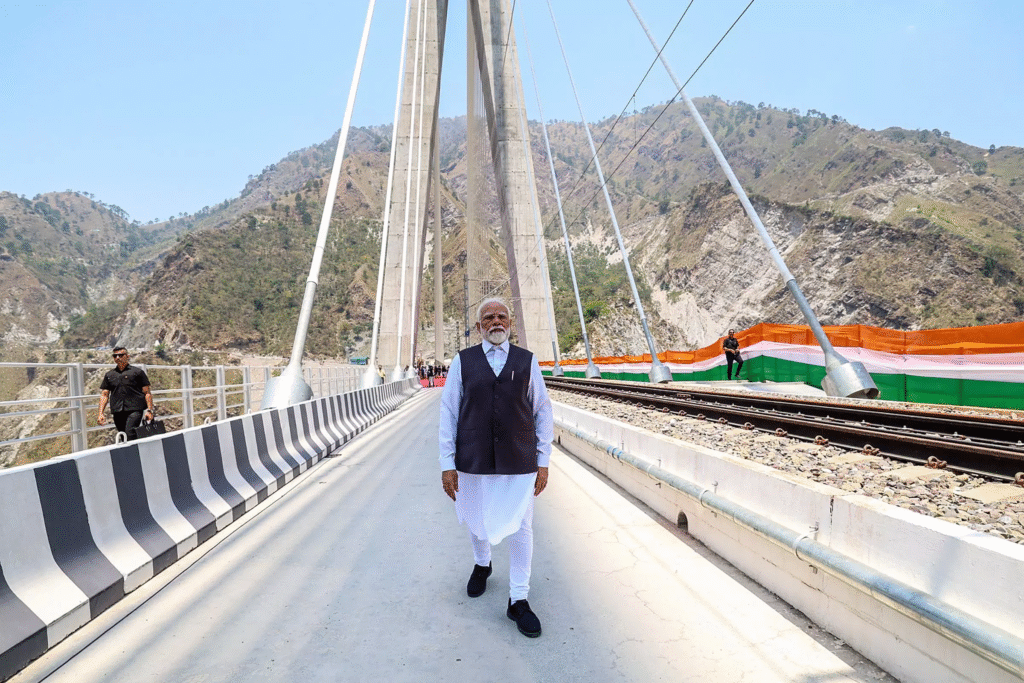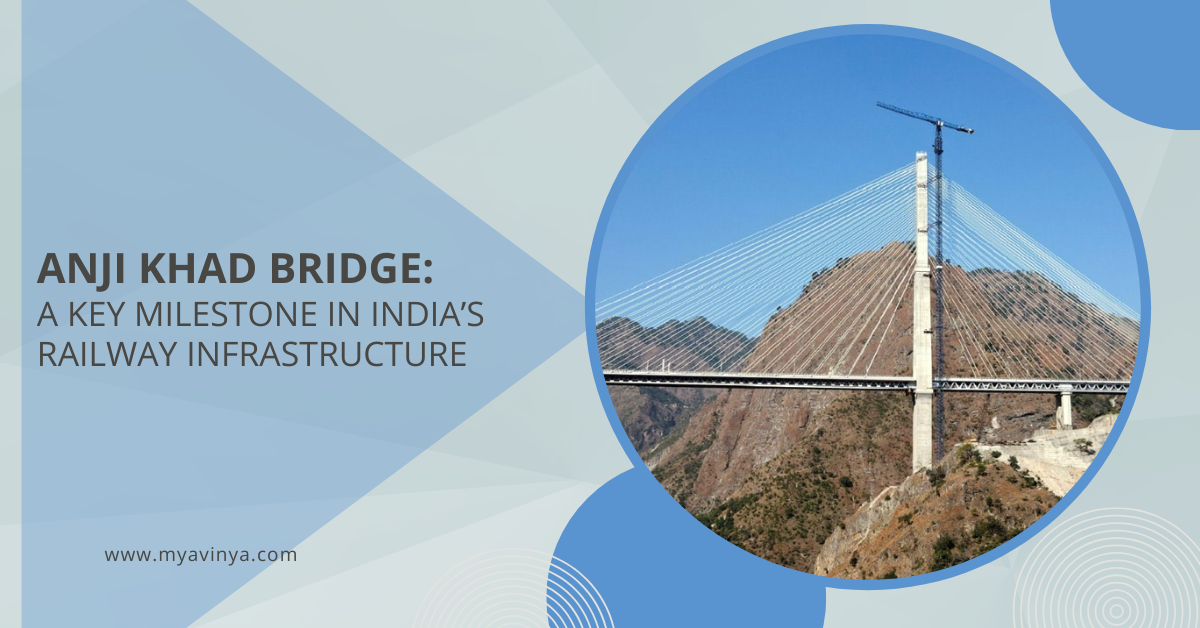The Anji Khad Bridge, situated in the Reasi district of Jammu and Kashmir, is an engineering marvel that marks a significant achievement in India’s railway infrastructure. As India’s first cable-stayed railway bridge, it represents the country’s advancing technical capabilities in building complex structures in challenging terrains.
Table of Contents
A Vital Link in the Udhampur-Srinagar-Baramulla Rail Link (USBRL)
The Anji Khad Bridge is a crucial part of the Udhampur-Srinagar-Baramulla Rail Link (USBRL) project, which aims to enhance rail connectivity between the Kashmir Valley and the rest of India. Spanning the Anji River, a tributary of the Chenab River, this bridge stands tall at 331 meters (1,086 feet), making it one of India’s tallest railway bridges.
Once completed, it will drastically reduce travel time between key towns such as Katra and Reasi, improving economic activities and facilitating better transportation of goods and people across the region.

Design and Engineering Excellence of the Anji Khad Bridge
What sets the Anji Khad Bridge apart is its asymmetrical cable-stayed design, which is a first for India’s railway bridges. The structure is supported by a single massive pylon located on the Reasi side, standing at 193 meters (633 feet) above the foundation. The bridge has 96 cables anchored to this pylon, creating a visually striking yet highly functional structure.
The total length of the Anji Khad Bridge is 725 meters (2,380 feet), with an impressive height of 331 meters above the riverbed. This engineering feat allows the bridge to span a deep gorge, withstanding the challenging conditions posed by the steep terrain of the region.
Key Milestones in the Construction of the Anji Khad Bridge
The construction of the Anji Khad Bridge has been a lengthy and complex process, with several significant milestones achieved over the years:
- 2016: Indian Railways officially approved the plan to build a cable-stayed bridge, marking the beginning of the USBRL project.
- January 2017: Hindustan Construction Company (HCC) initiated the construction of the bridge.
- March 2021: The Reasi-side pylon was completed, providing the foundation for the 96 cables.
- April 2023: The installation of all 96 cables was completed, bringing the project to the final stages.
- August 2023: A successful trial run confirmed the bridge’s capacity to handle the railway tracks and other load-bearing conditions.
- December 2024: Extensive load testing was conducted with heavy-duty trains and trucks to ensure structural integrity.
- January 2025: Speed trials were completed successfully at speeds of up to 110 km/h.
Anji Khad Bridge vs. Chenab Rail Bridge: A Comparative Overview
While both the Anji Khad and Chenab Rail bridges are part of the USBRL project, they differ significantly:
- The Chenab Rail Bridge, at 359 meters (1,178 feet), is the tallest railway bridge in the world, surpassing even the Eiffel Tower in height. It stands as a global engineering achievement.
- The Anji Khad Bridge, while slightly shorter at 331 meters, remains a groundbreaking structure as India’s first cable-stayed railway bridge, designed to adapt to the region’s rugged geography and seismic activity.
Economic and Tourism Impact of the Anji Khad Bridge
The Anji Khad Bridge is not just an engineering marvel; it has the potential to transform the local economy and boost tourism in Jammu and Kashmir:
- Economic Growth: The improved connectivity brought by the Anji Khad Bridge will facilitate the smoother transportation of goods, boosting industries such as agriculture and trade.
- Tourism Boost: As the bridge becomes an iconic landmark, it is expected to attract both national and international tourists. The scenic beauty of the region, combined with the structural grandeur of the Anji Khad and Chenab Bridges, will position Jammu and Kashmir as a hub for engineering enthusiasts and nature lovers alike.
- Improved Connectivity: The introduction of the Vande Bharat Express between Katra and Srinagar, passing over both the Chenab and Anji Khad Bridges, will drastically cut down travel times, making it easier for both tourists and locals to move around the region.
The Future of India’s Railway Infrastructure
The Anji Khad Bridge marks a new era in India’s railway infrastructure. It not only demonstrates the country’s ability to handle complex engineering projects in difficult environments but also sets the stage for future large-scale infrastructure developments.
Is Chenab Bridge and Anji Khad Bridge the same?
The Chenab Bridge is higher than the Eiffel Tower. Anji Khad Bridge is the longest cable-stayed railway bridge in the country. There are many tunnels between Katra and Banihal. The project will be boost for economy and tourism
What does the Anji Khad bridge connect?
It connects the towns of Katra and Reasi, standing 331 m (1,086 ft) meters above the riverbed below.
What is the height of Anji bridge?
India’s first cable-stayed railway bridge. Total length: 725 metres. Height above riverbed: 331 metres.
Conclusion
The Anji Khad Bridge stands as a testament to India’s growing capabilities in civil engineering. With its innovative design, remarkable height, and essential role in the USBRL project, it serves as a key milestone in the modernization of India’s railway infrastructure. In combination with the Chenab Rail Bridge, the Anji Khad Bridge exemplifies the country’s ambition to transform its transport network, promote economic growth, and integrate remote regions into the national framework.

